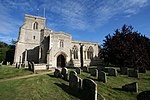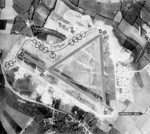Little Milton, Oxfordshire

Little Milton is a village and civil parish in Oxfordshire, about 6 miles (10 km) southwest of Thame and 7 miles (11 km) southeast of Oxford. The parish is bounded to the west by the River Thame, to the south by Haseley Brook (a tributary of the Thame), to the north by field boundaries and to the east by an old track between Great Milton and Rofford that is now a bridleway. Little Milton village is on raised ground above the River Thame floodplain, about 250 feet (76 m) above sea level. The A329 road between Thame and Shillingford via Stadhampton passes through the village. In the centre of the village is the Grade II listed Milton Manor, parts of which date back to the 15th century. The Church of England parish church of Saint James is a Gothic Revival building designed by John Hayward and built in 1844. Hayward also designed the west tower, which was added in 1861.
Excerpt from the Wikipedia article Little Milton, Oxfordshire (License: CC BY-SA 3.0, Authors, Images).Little Milton, Oxfordshire
Milton Manor Drive, South Oxfordshire
Geographical coordinates (GPS) Address Nearby Places Show on map
Geographical coordinates (GPS)
| Latitude | Longitude |
|---|---|
| N 51.703 ° | E -1.106 ° |
Address
Milton Manor Drive
Milton Manor Drive
OX44 7QB South Oxfordshire
England, United Kingdom
Open on Google Maps









